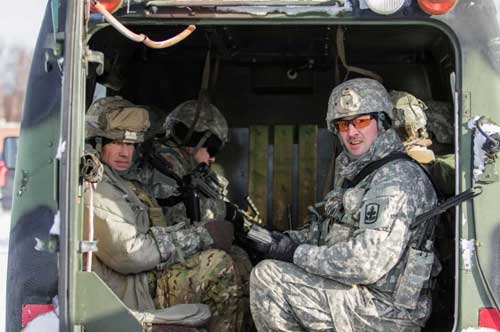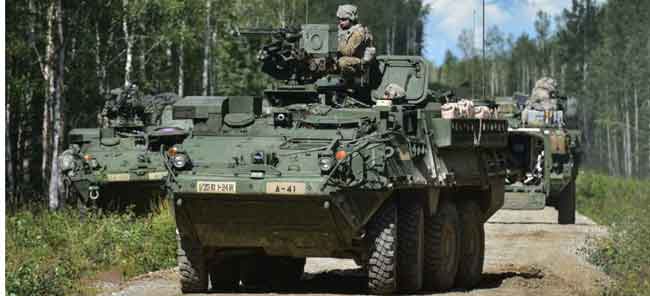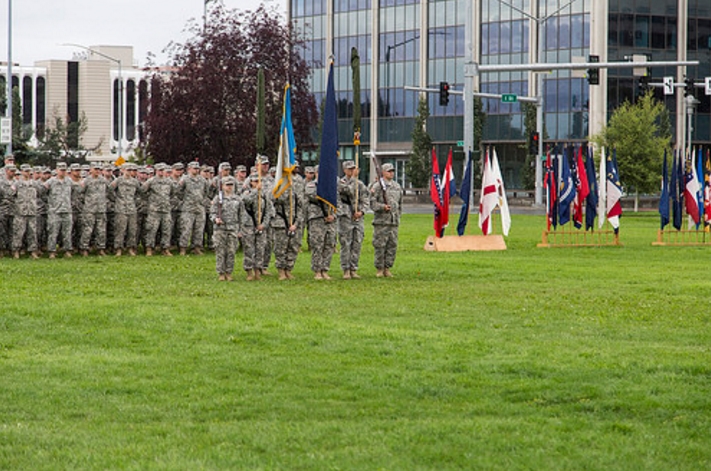
BETHEL, Alaska — Bison Company, 1st Battalion, 297th Infantry Regiment, demonstrated readiness and resilience during their cold weather training in Bethel, Alaska, February 2-4, 2024.
This training marked a significant reunion for the Alaska Army National Guard infantry unit in Bethel, emphasizing the city’s importance as a training ground that challenges Soldiers to adapt and excel in real-world scenarios.
Alaska Army Guard 1st Lt. Troy Irish, Bison Company’s rear detachment commander, from Fairbanks, explained that the rugged terrain and extreme weather conditions in Western Alaska provide an ideal testing ground for his Soldiers preparing for arctic warfare. Bethel, located on the Kuskokwim River and 340 miles west of Anchorage, set the scene for the training with its snow-covered landscape of tundra marshes, and frozen lakes and streams.
“It’s just you, your rucksack, and the terrain,” said Irish, reflecting on the solitude of the tundra. “During our snowshoe ruck, I wasn’t initially sure about my gear—polypro, waffletops, and [soft shell jacket]—but trusted my noncommissioned officers. Wearing the right gear broke the wind, and I maintained a comfortable temperature, crucial in preventing freezing due to precipitation or sweat.”
Despite spending less than nine months in the Alaska Army National Guard, Irish expressed increased confidence in his gear through this training, marking his first experience in Western Alaska.
Throughout the three days, the infantry unit engaged in realistic training exercises that rigorously tested their field-craft skills, individual movement over arctic terrain, and arctic transportation proficiency.
The Guardsmen showcased their capabilities by operating Small Unit Support Vehicles and sleeping in the snow amid negative temperatures. Equipped with the Army Modular Sleep System, consisting of the Patrol Sleeping Bag, Intermediate Cold Weather Bag, and Waterproof Bivy Cover, the Soldiers effectively insulated themselves in temperatures ranging from -10 to -15 with a -20-degree wind chill.
“The sleep systems are rated to a certain negative temperature, and we were nearing that overnight. So, there were a lot of Soldiers that were kind of cold. But nobody was injured. Nobody was hypothermic. They did what they were supposed to do,” said Irish, emphasizing the importance of the gear.
The training regimen also included assembling and utilizing the Ahkio Group – a sled with an arctic 10-man tent and other squad cold-weather supplies, to sleep in and operate throughout the training.
“We’ve talked about them a lot, we’ve done a lot of prep work for them, but I’ve never really been able to truck them out into the field and use them before,” Spc. Luke Barnes, an infantryman from Palmer who joined the AKARNG three years ago. “So, getting to actually take those out in a practical environment where they’re necessary and get to set them up was great for me.”
The company successfully completed a 5 kilometer snowshoe ruck march, pulling the Ahkio group with them. The sleds were equipped with a harness system, enabling one squad member to pull the sled.
Barnes explained that while he isn’t a noncommissioned officer yet, he has noticed personal growth during the training as he navigates his potential responsibilities. He enjoyed the added responsibility of taking care of and leading others, he said.
The unit’s last consolidated training in the area coincided with the 2018 Kuskokwim 300 sled dog race. Training focus shifted as more than 150 Guardsmen from the 1-297th deployed to Kosovo from 2019-2020. Following a month-long rotation at the Joint Readiness Training Center in Fort Polk, La., in the summer of 2023, approximately 100 Bison Company Guardsmen deployed to Kuwait in November as part of Operation Spartan Shield.
“Coming from JRTC in the summer, we’ve been really training hard for [warm weather] and getting ready to be deployable,” said Irish, explaining that now his unit is getting back into arctic operations. “Bethel is kind of the perfect training area for that.”
The primary training objective, as highlighted by Irish, was reacquainting themselves with arctic conditions, testing systems, familiarizing with gear, and operating in a non-tactical environment. This involved getting back into snowshoes, donning rucksacks, and setting up equipment amidst the cold winds and snow—a crucial step for Bison Company returning to arctic operations.
###[content id=”79272″]








